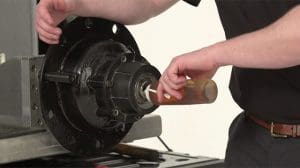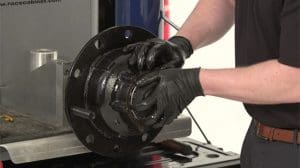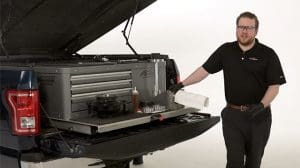Les roulements sont au cœur du camionnage commercial. Une qualité inférieure peut coûter bien plus cher que l’argent économisé. Heureusement, STEMCO est reconnue depuis longtemps au sein de l'industrie des camions lourds comme un fournisseur de qualité de produits d'extrémité de roue haut de gamme. Nos roulements robustes offrent une qualité et une fiabilité inégalées et font partie de notre promesse de rendre les routes plus sûres.
Le but de ces ressources routières est d'informer nos clients des méthodes appropriées de retrait et d'installation des roulements robustes STEMCO. Nous ferons référence aux PDF STEMCO suivants :
Dépose des roulements
ÉTAPE 1
Retirez l'ensemble moyeu/roue du véhicule conformément aux pratiques recommandées.
ÉTAPE 2
Retirez les cônes de roulement intérieurs et extérieurs et mettez-les de côté pour inspection.
ÉTAPE 3
À l’aide d’une dérive en acier doux ou d’un tournevis à coupelle, chassez soigneusement les cuvettes de roulement.
- Il convient d'être prudent lors de l'entraînement des cuvettes de roulement, car les dérives et autres outils peuvent endommager les roulements.
- Les dérives peuvent endommager les alésages des roulements de moyeu. Faites attention à ne pas rayer les alésages lors du retrait des coupelles, en particulier lorsque vous utilisez des moyeux en aluminium.
Inspection des roulements
ÉTAPE 1
Inspectez les alésages et les épaulements des roulements de moyeu pour déceler tout dommage. Les alésages doivent être lisses et exempts de rayures, de bavures, d'indications de rotation de la coupelle ou d'autres formes de dommages. Retirez toutes les bavures ou zones surélevées à l'aide d'une toile émeri, d'une lime ou de tout autre outil approprié.
ÉTAPE 2
Mesurez l’alésage de la cuvette de roulement et comparez-le aux spécifications du fabricant.
ÉTAPE 3
Inspectez les cuvettes et les cônes de roulement pour déceler tout dommage. Les roulements doivent être exempts de copeaux, de contamination et de signes d'usure excessive ou de chaleur excessive. Reportez-vous à la documentation sur l'analyse des dommages aux roulements pour identifier d'éventuels problèmes de roulement.
ÉTAPE 4
Inspectez les tourillons de roulement d’axe d’essieu pour déceler tout signe de dommage ou d’usure excessive. Retirez toutes les zones surélevées ou bavures à l'aide d'une toile émeri, d'une lime ou de tout autre outil approprié.
ÉTAPE 5
Les journaux doivent être mesurés et comparés aux spécifications du fabricant.
Installation des roulements
ÉTAPE 1
Nettoyer soigneusement les cuvettes et les cônes de roulement avant l'installation.
- N'utilisez pas d'air comprimé pour faire tourner les rouleaux de roulement, car des blessures pourraient survenir si la cage ne retient pas les rouleaux.
ÉTAPE 2
Enduire légèrement l’extérieur des cuvettes de roulement d’huile.
ÉTAPE 3
À l'aide d'un tournevis à cuvette, enfoncez soigneusement les cuvettes de roulement dans les alésages de roulement de moyeu. Être
assurez-vous d'enfoncer fermement la coupelle contre l'épaulement de la coupelle dans le moyeu.
- Si aucun outil d'entraînement de cuvette n'est disponible, une dérive en acier doux peut être utilisée pour installer les cuvettes de roulement.
- Il convient d'être prudent lors de l'entraînement des cuvettes de roulement, car les dérives et autres outils peuvent endommager les roulements.
- N’utilisez JAMAIS un cône de roulement pour entraîner une cuvette de roulement. Cela peut endommager les roulements et provoquer une défaillance prématurée.
ÉTAPE 4
Utilisez une jauge d'épaisseur pour vérifier les espaces entre la tasse et l'épaule.
ÉTAPE 5
Inspectez les cuvettes de roulement pour vous assurer qu’aucun dommage ne s’est produit lors de l’installation.
ÉTAPE 6
Lubrifiez les cônes de roulement selon les pratiques recommandées et procédez à l'installation de l'ensemble de roue.
Si vous souhaitez plus d'informations sur les roulements robustes STEMCO, visitez notre fiche produit.
Pour accéder à notre bibliothèque complète de ressources routières, Cliquez ici.
Pour des articles approfondis couvrant l'actualité et les tendances du secteur, les produits phares, les études de cas, les informations sur les clients et les sujets de « leadership éclairé » rédigés par des professionnels de STEMCO, visitez Le blog de la timonerie.


